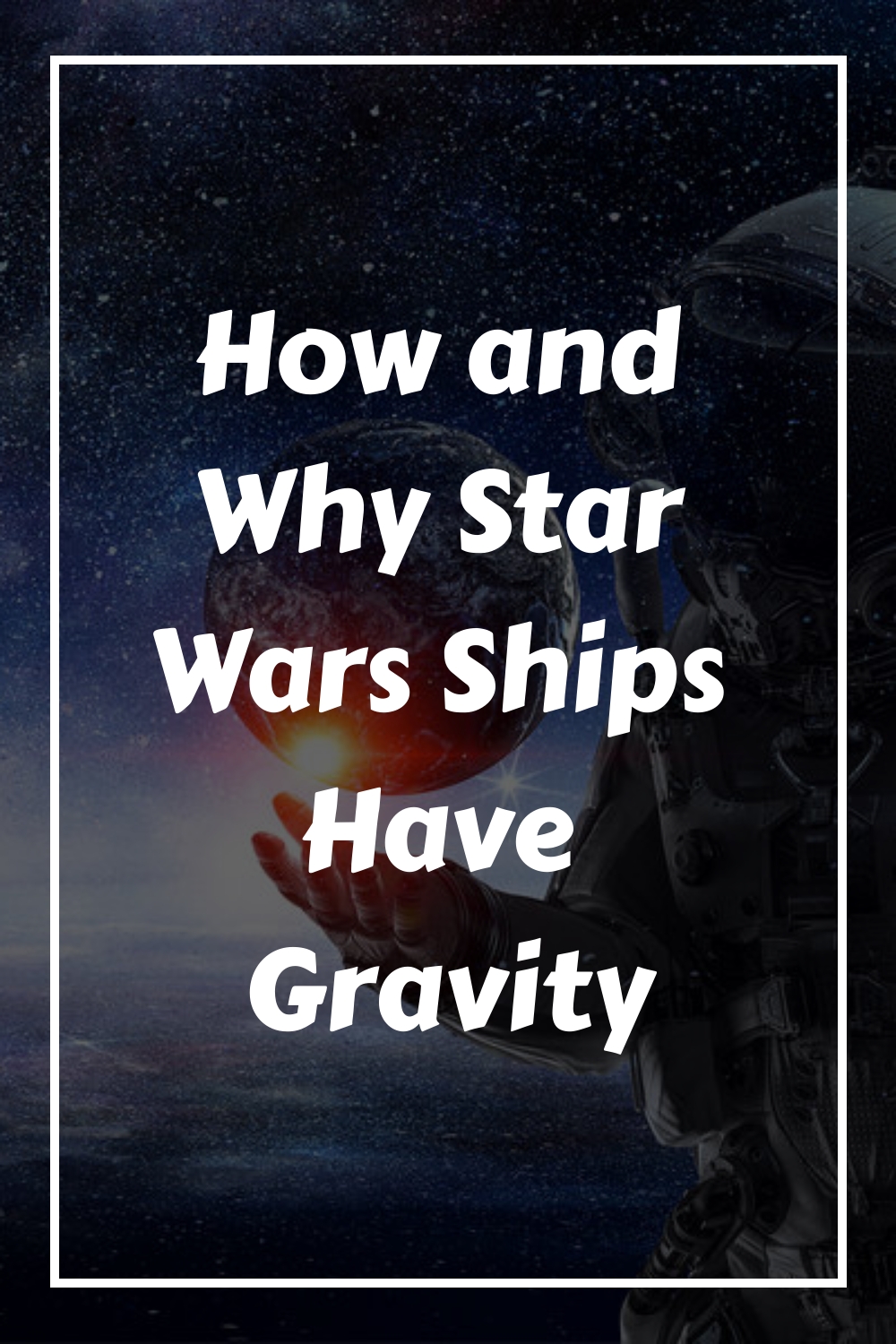Everyone, for the most part, knows about Star Wars. How can you not? The lightsabers, the cool space ships, the epic space battles, the complicated father and son story. It is a series full of intrigue and science fiction wonders meant to captivate an audience of any generation. There is one thing that people want to know about: How are they not floating around everywhere in their ships?
Why and how do the ships in Star Wars have gravity? The purpose of the ships in Star Wars having gravity is to give the occupants of the ships the ability to remain upright when traversing about their ships. This is accomplished through the use of artificial gravity that is implemented aboard the ships. This allows the occupants to move about the ship and not succumb to the effects of weightlessness.
If you are a science fiction geek and want to get a better understanding of how artificial gravity works aboard the star ships featured in Star Wars, you are in the right place. Within this article, we are going to examine how the occupants aboard the ships in Star Wars manage to keep themselves upright and no float around aimlessly in the free space of Star Wars and explain the methods of how they do it.
Why Is Artificial Gravity So Important in Star Wars?
In the real world, we do not currently have the technology available to artificially replicate the effects of gravity aboard a spacecraft. Instead, our astronauts train and prepare to live in a weightless environment by training in water and modified C-9 airplane to simulate and conduct experiments on weightlessness and reduce the cost associated with actual space launches before a mission.
What has been discovered through these experiments and information gathered from sending humans into space to conduct missions have given us valuable information on the effects of being in a zero-gravity environment for a long period of time. What we have learned is that zero-gravity has a lot of negative impacts on the human body. These negative side effects are as listed:
Loss of Muscle Mass and Bone Density
Even in Star Wars, the effects of being in space without feeling the effects of gravity could cause some very unpleasant and unwanted side effects. Two of those being the loss of muscle mass and bone density. While gravity technically exists everywhere in the universe, as it is the force of two bodies against each other, you may not feel those effects in space, creating that weightless feeling.
When a body is effectively weightless, gravity is not applying pressure to the body’s spine or legs. Due to there not being any pressure being applied to these areas of the body, they cease to function because they have no need to. Without the need to support the weight of the body, the muscle tissue begins to undergo atrophy, becoming weaker and smaller and the density of the bones beginning to decline.
The heart is also a muscle that is affected by extended periods of weightlessness. When the body experiences this for a long period of time, the heart begins to degenerate due to not needing to pump blood at the same pressure as when on a planet that has sufficient gravity, the involuntary muscle becomes dramatically weaker. This can lead to less blood to the brain and low blood pressure.
Redistribution of Fluids in the Body
The body is composed of 60 percent water. Being weightless for an extended period of time affects the fluids in the body by bringing the fluids upwards. This redistribution of fluids in the body can affect the brain and blur your vision until your eyes and brain adjust to the new environment.
This fluid redistribution can also affect an individual’s sense of balance, taste, and hearing. Aside from this, there is another issue that can develop is what is called orthostatic intolerance. This means that the individual will not be able to stand on their own without assistance. This, coupled with the weakened muscles and bones the body will end up being extremely weak from prolonged exposure to zero-gravity.
The Application of Artificial Gravity in Star Wars
With the amount of time that they spend in space, characters in Star Wars will definitely feel the effects of being in a zero-gravity environment even though they are fictional characters they are still susceptible to the rules of being in space. To combat the effects of being in an environment that doesn’t feel the effects of gravity, artificial gravity generators were developed to aid those living in space.
Artificial gravity generators were used and applied to create stable fields of gravity outside of the crew’s planet’s natural gravity well and also to compress (squeeze) various objects. This allowed for the storage of gaseous items that were needed and also was necessary for the creation of various synthetic gems that the crews would use or potentially be in need of.
These gravity generators would be placed on virtually every large spacecraft and battle station to aid the occupants of the ship and help promote not only a sense of direction but also keep the crew members upright while they were working and moving about their ship. This was another profound reason to generate and utilize artificial gravity generators aboard starships in Star Wars.
Gravity as Defined By Star Wars & Its Importance
In Star Wars, gravity is defined as the attraction between two bodies, dependent on their mass and the distance between them (Star Wars & Gravity). Everything, no matter how big or small has its own gravitational pull on another object, however, dependent upon the mass of the object, that will determine the actual effect of its gravitational pull.
Over the course of multiple millennia, galactic civilizations have developed gravity manipulating technology and have applied it to suit their particular needs. Whether it has been for colonization of other planets, space travel, or military applications, gravity generation technology has been at the forefront of these galactic civilizations. Here some examples of artificial gravity at work:
Repulsor Lifts:
Repulsor lifts utilized artificial gravity technology to allow these special types of crafts to hover over a planet’s surface by pushing against the planet’s gravity. This application of gravity technology was seen in devices such as chairs and speaker podiums. It was also applied to multiple vehicles as well. The vehicles most prominently seen utilizing repulsor lifts were speeder bikes and starships among others.
Repulsor lifts also had seen a weaponization of the repulsor artificial gravity technology as well. The Maladorians actually implemented this well with the creation of the Maladorian Vambraces that gave them an ability similar to the force push allowing them to repel enemies with an artificial gravity shockwave.
Repulsor artificial gravity technology can also be seen being utilized in Gian speeder, the Single Trooper Aerial Platform, the Flash speeder, the AAT Battle Tank, and the patrol transports.
Acceleration Compensators
Acceleration compensators (also known as inertia dampeners) manipulated gravity aboard ships moving at high speeds to ensure the survival of crew members.
They also compensated for the intense and rapid increases in speed that were common during space travel, especially during situations of chase and evasion. This prevented the deaths of occupants aboard the starships by causes due to excessive G-Forces and inertia.
“Inertial dampeners helped for a time to protect the remains of the Supremacy, the flagship of the First Order, following the Resistance vessel Raddus ramming into it coming out of hyperspace. Ultimately, however, the vessel was catastrophically damaged, forcing its abandonment.” (Wookieepedia, 2019)
As you can see, acceleration compensators were an integral component to any starship, and most notably, the beloved Star Wars fan-favorite, The Millenium Falcon. This ship was known for its incredible speed and acceleration, including its high-speed maneuvers.
Without the gravity manipulation of the acceleration compensators, it wouldn’t have been able to accomplish these feats without causing the deaths of the crew aboard the starship.
Tractor Beams
Instantly recognizable by any fan of the Star Wars series or anyone who has wondered about extraterrestrial life, the tractor beam of Star Wars manipulated gravity in a way that allowed a vessel to push an object such as a starship away or even pull a starship aboard the vessel.
The tractor beams aboard vessels also allowed them to lock onto a target and surround another object with the energy of the tractor beam before pulling it aboard the vessel that has employed the tractor beam technology.
While there are multiple vessels within Star Wars that employed the use of tractor beams, including the Republic tugboat, the most notable vessel that has utilized tractor beams is the Empire’s DS-1 Orbital Battle Station, better known as the Death Star 1.
This moon-sized vessel was equipped with 768 gravity manipulating tractor beam emplacements that allowed the superweapon the capability to draw in multiple vessels and simultaneously target multiple vessels.
This was one of the most prominent offensive and defensive measures aboard the DS-1 Orbital Battle Station and caused the Rebel Alliance to fear potential capture by the empire due to these emplacements. To learn more about the Death Star and its armaments and defenses take a look at this overview of the Death Star.
Gravity Well Projectors
Gravity well projectors were devices that were designed and built to pull starships out of hyperspace. The premise of the gravity well projector was to replicate the effects that planets have on ships. In Star Wars, ships cannot usually enter hyperspace while within a planet’s gravitational pull.
The gravity well projector imitated a planet’s ability to prevent ships from entering hyperspace by creating an artificial gravity well that was strong enough to hamper a ship’s ability to do so and to pull a ship out of hyperspace when in pursuit of a vessel. These gravity wells were also known as interdiction fields.
This was a piece of equipment utilized by the Imperial forces against the Rebel Alliance, actually placing them into a trap by preventing them to enter hyperspace and locking them into position. Gravity wells or interdiction fields were typically used by Imperial gunners.
Notable Vessels in Star Wars
Now that we have covered the why and how starships used gravity in this cult-classic series, we are going to take a look at some of the iconic ships that have made an appearance in the series, discuss their armaments and defenses and get a brief overview of the ships and their capabilities.
The Fastest Hunk of Junk in the Galaxy… The Millennium Falcon
The Millennium Falcon is a modified YT-1300 light freighter with a very unique and storied past. After decades of being destroyed, bought, sold, and gambled away it had eventually ended up in the hands of its most famous and recognizable owners ever, Han Solo and his Wookie First Mate Chewbacca.
Over the years what was perceived as a piece of junk turned out to be one of the Rebel Alliance’s most important assets and combat-ready ships. Throughout its lifetime the Millennium Falcon had received many upgrades and improvements (many of which were not even legal) and it became an unpredictable force of nuts and bolts that helped the Rebel Alliance defeat the Imperial Military.
Millennium Falcon Upgrades and Systems
The Millennium Falcon underwent numerous modifications and rebuilds in its time of ownership between Lando and Han Solo. Due to both of these owners being smugglers, it is important to note that quite a few of the modifications served that particular business function and inadvertently also made it an indispensable asset to the Rebel Alliance as well.
Hidden Cargo Sections: During his time owning the Millennium Falcon, Lando had hidden cargo sections installed into the Millennium Falcon. This was extremely beneficial that allowed for an increased smuggling haul and storage of supplies aboard the ship. It also allowed the crew to hide when captured by the DS-1 Orbital Battle Station.
Increased Shielding: During his tenure as owner of the Millennium Falcon, Lando made a point to increase the shielding of the Millennium Falcon beyond its original capacity. With this upgrade of defenses, the Millennium Falcon was definitely more durable than it looked and able to take much more punishment than the average starship.
Blasters Attached to Ship Mandibles: Another one of the notable upgrades that Lando made to the Millennium Falcon was the installation of smaller blasters onto the mandibles of the ship. This allowed for increased offensive capabilities and added firepower to the ship.
Duralloy Armored Plating: The Millenium Falcon was equipped with Duralloy plating around the most vulnerable areas of the ship. This allows the ship more resistance from damage to areas that would normally render the ship useless.
Acceleration Compensators: The Millennium Falcon has seen major upgrades to its speed and maneuverability due to the needs of Lando and Han Solo, earning it the nickname “Fastest Piece of Junk in Space.”
With the upgraded speed and maneuverability systems, there is a need to ensure the safety of the crew during these increases in speed and maneuvers. See acceleration compensators above to learn more about how this is beneficial to the Millennium Falcon.
Customized Class 0.5 Hyperdrive: This contributes to the Millennium Falcon’s legendary speed. In fact, it is nearly impossible for an Imperial warship to catch it. Due to the upgrades and the Class 0.5 Hyperdrive, it is actually twice as fast as any of the Imperial warships.
To learn more about the weapons and defenses of the Millennium Falcon visit the Millennium Falcon’s dedicated page. You’ll get more information on the ship, its history, and its owners as well.
DS-1 Orbital Battle Station
No one can forget this mobile space battle station that the Empire created to demonstrate their power and strike fear into their enemies. This planet-destroying battle station was equipped with 768 tractor beams, artificial gravity that kept its over 2 million crew in a survival environment and upright, and an unbelievable amount of firepower and defenses that kept enemies at bay.
Aside from that, the battle station was so massive that it actually had its own acting gravitational pull that could actually draw starships into it and was so strong that TIE Fighters needed to add extra power to takeoff from the battle station.
It seems fitting to place the Death Star on this section next to the Millennium Falcon. Not because the Millennium Falcon played a role in the destruction of the Death Star… twice. To up your Star Wars trivia knowledge on the Death Star take a look at this Death Star 1 overview. There’s a lot of information on this planet-crushing superweapon there.
In Conclusion
We have gone over a lot in explaining all the reasons gravity is used aboard starships in Star Wars and how the feat is accomplished. Gravity plays a major role in every aspect of Star Wars. From keeping the crews aboard ships upright and healthy and being used in other functions like transportation, military application, and pulling ships out of hyperspace.
We are pretty sure you learned a lot about gravity and the role it plays in Star Wars, to learn more about the individual pieces of gravity technology and how gravity is used in Star Wars, click on any of the links in this article and “The wiser, be you will.” Thanks for reading!





Leave a comment
You must be logged in to post a comment.